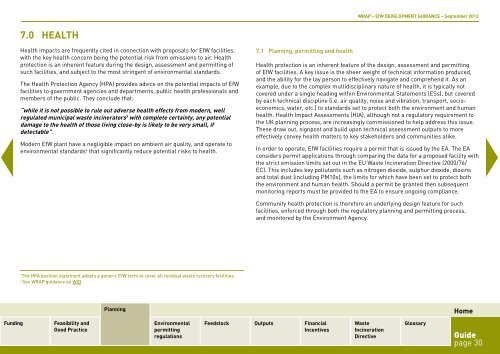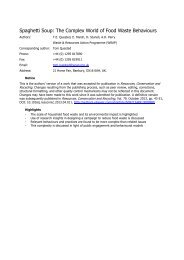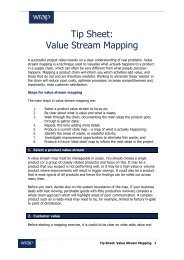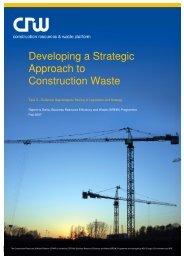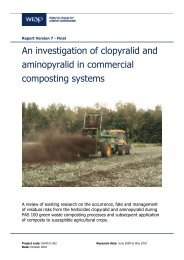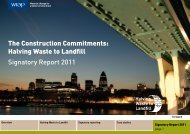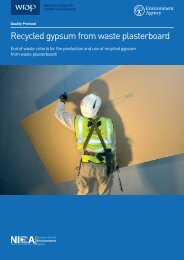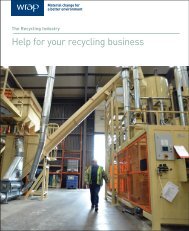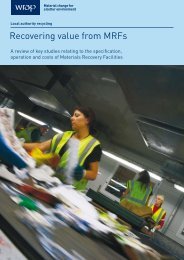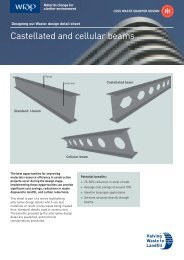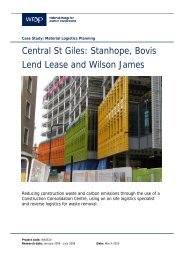EfW DEVELOPMENT GUIDANCE - Wrap
EfW DEVELOPMENT GUIDANCE - Wrap
EfW DEVELOPMENT GUIDANCE - Wrap
You also want an ePaper? Increase the reach of your titles
YUMPU automatically turns print PDFs into web optimized ePapers that Google loves.
WRAP – <strong>EfW</strong> <strong>DEVELOPMENT</strong> <strong>GUIDANCE</strong> – September 2012<br />
7.0 Health<br />
Health impacts are frequently cited in connection with proposals for <strong>EfW</strong> facilities,<br />
with the key health concern being the potential risk from emissions to air. Health<br />
protection is an inherent feature during the design, assessment and permitting of<br />
such facilities, and subject to the most stringent of environmental standards.<br />
The Health Protection Agency (HPA) provides advice on the potential impacts of <strong>EfW</strong><br />
facilities to government agencies and departments, public health professionals and<br />
members of the public. They conclude that:<br />
“while it is not possible to rule out adverse health effects from modern, well<br />
regulated municipal waste incinerators 3 with complete certainty, any potential<br />
damage to the health of those living close-by is likely to be very small, if<br />
detectable”.<br />
Modern <strong>EfW</strong> plant have a negligible impact on ambient air quality, and operate to<br />
environmental standards 4 that significantly reduce potential risks to health.<br />
7.1 Planning, permitting and health<br />
Health protection is an inherent feature of the design, assessment and permitting<br />
of <strong>EfW</strong> facilities. A key issue is the sheer weight of technical information produced,<br />
and the ability for the lay person to effectively navigate and comprehend it. As an<br />
example, due to the complex multidisciplinary nature of health, it is typically not<br />
covered under a single heading within Environmental Statements (ESs), but covered<br />
by each technical discipline (i.e. air quality, noise and vibration, transport, socioeconomics,<br />
water, etc.) to standards set to protect both the environment and human<br />
health. Health Impact Assessments (HIA), although not a regulatory requirement to<br />
the UK planning process, are increasingly commissioned to help address this issue.<br />
These draw out, signpost and build upon technical assessment outputs to more<br />
effectively convey health matters to key stakeholders and communities alike.<br />
In order to operate, <strong>EfW</strong> facilities require a permit that is issued by the EA. The EA<br />
considers permit applications through comparing the data for a proposed facility with<br />
the strict emission limits set out in the EU Waste Incineration Directive (2000/76/<br />
EC). This includes key pollutants such as nitrogen dioxide, sulphur dioxide, dioxins<br />
and total dust (including PM10s), the limits for which have been set to protect both<br />
the environment and human health. Should a permit be granted then subsequent<br />
monitoring reports must be provided to the EA to ensure ongoing compliance.<br />
Community health protection is therefore an underlying design feature for such<br />
facilities, enforced through both the regulatory planning and permitting process,<br />
and monitored by the Environment Agency.<br />
1<br />
The HPA position statement adopts a generic <strong>EfW</strong> term to cover all residual waste recovery facilities.<br />
2<br />
See WRAP guidance on WID<br />
Planning<br />
Home<br />
Funding<br />
Feasibility and<br />
Good Practice<br />
Environmental<br />
permitting<br />
regulations<br />
Feedstock Outputs Financial<br />
Incentives<br />
Waste<br />
Incineration<br />
Directive<br />
Glossary<br />
Guide<br />
page 30


